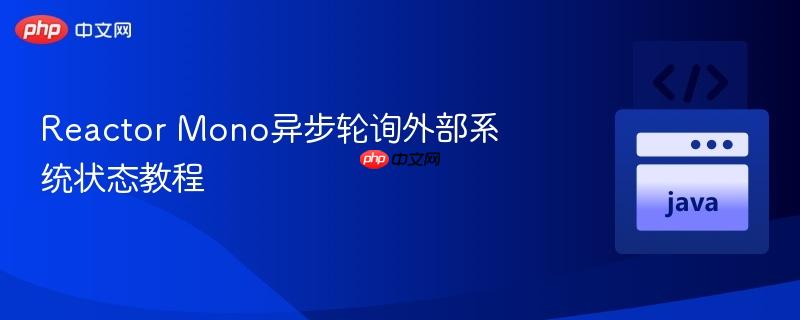
本文深入探讨了在reactor框架中实现异步轮询外部系统状态的两种主要策略:基于`retrywhen`的重试机制和基于`flux.interval`的固定间隔轮询。文章将分析这两种方法的优缺点、适用场景,并提供详细的代码示例和最佳实践,帮助开发者根据具体需求选择最合适的轮询方案,确保系统的高效与稳定。
在现代微服务架构和异步编程中,应用程序经常需要与外部系统进行交互,并等待其状态变为可用或就绪。这种等待通常通过轮询(polling)机制实现,即定期发送请求查询状态,直到满足特定条件。Reactor作为Java领域流行的响应式编程框架,提供了强大的工具来优雅地处理这类异步轮询任务。本文将详细介绍两种常见的Reactor轮询策略,并进行对比分析。
retryWhen 操作符是Reactor中处理失败和重试的强大工具。它可以根据特定的错误信号或条件来触发重试逻辑,非常适合实现“直到成功”的轮询模式。
原始问题中展示的代码片段是retryWhen策略的一个典型应用。其核心思想是:发起一个状态检查请求,如果状态不满足条件(例如,系统未就绪),则通过抛出特定异常来触发retryWhen,从而在设定的延迟后再次尝试。
import reactor.core.publisher.Mono;
import reactor.util.retry.Retry;
import org.springframework.web.reactive.function.client.WebClient;
import java.time.Duration;
// 假设的状态枚举和自定义异常
enum Status { READY, PENDING, ERROR; public boolean isReady() { return this == READY; } }
class SystemStateNotReadyException extends RuntimeException {}
public class RetryWhenPolling {
private final WebClient webClient = WebClient.create("http://localhost:8080"); // 示例WebClient
private Mono<Status> checkStatus() {
// 模拟外部系统状态检查,这里可以替换为实际的WebClient调用
return webClient.get()
.uri("/status")
.retrieve()
.bodyToMono(String.class)
.map(response -> {
// 实际场景中,根据response解析状态
if (Math.random() > 0.7) { // 模拟70%的概率就绪
return Status.READY;
} else {
return Status.PENDING;
}
});
}
public Mono<Status> pollUntilReadyWithRetry() {
final int MAX_ATTEMPTS = 5;
final Duration BACK_OFF = Duration.ofSeconds(1);
return checkStatus()
.filter(status -> status.isReady()) // 只有当状态为READY时才通过
.switchIfEmpty(
// 如果状态不是READY,则抛出异常以触发重试
Mono.error(new SystemStateNotReadyException())
)
.retryWhen(
// 配置重试策略:固定延迟,并只对特定异常进行重试
Retry.fixedDelay(MAX_ATTEMPTS, BACK_OFF)
.filter(err -> err instanceof SystemStateNotReadyException)
.onRetryExhaustedThrow((retryBackoffSpec, retrySignal) ->
new RuntimeException("Polling failed after " + MAX_ATTEMPTS + " attempts"))
);
}
public static void main(String[] args) {
RetryWhenPolling poller = new RetryWhenPolling();
System.out.println("Starting polling with retryWhen...");
poller.pollUntilReadyWithRetry()
.doOnNext(status -> System.out.println("System is READY: " + status))
.doOnError(error -> System.err.println("Polling failed: " + error.getMessage()))
.block(); // 阻塞等待结果,仅用于演示
System.out.println("Polling finished.");
}
}在Reactor中,Mono和Flux是不可变的,并且其操作符是线程安全的。Reactor框架本身旨在处理异步和并发场景,并管理资源。因此,上述retryWhen代码片段在设计上是线程安全的,并且只要订阅者正确处理(例如,取消订阅),通常不会导致内存泄漏。Reactor的背压机制也有助于防止系统过载。
当需要严格控制轮询的频率,使其与外部系统的响应时间无关时,Flux.interval 是一个更合适的选择。它允许在固定时间间隔内周期性地发出信号。
Flux.interval 会在指定的时间间隔后发出一个递增的Long值。我们可以利用这个特性,在每个间隔点触发一次状态检查请求。
import reactor.core.publisher.Flux;
import reactor.core.publisher.Mono;
import reactor.util.function.Tuple2;
import reactor.util.function.Tuples;
import org.springframework.web.reactive.function.client.WebClient;
import java.time.Duration;
// 假设的状态枚举
enum Status { READY, PENDING, ERROR; public boolean isReady() { return this == READY; } }
// 辅助类,用于记录轮询次数和状态
class Report {
long count;
Status status;
public Report(long count, Status status) {
this.count = count;
this.status = status;
}
@Override
public String toString() {
return "Report[count=" + count + ", status=" + status + "]";
}
}
public class IntervalPolling {
private final WebClient webClient = WebClient.create("http://localhost:8080"); // 示例WebClient
private Mono<Status> fetchStatus() {
// 模拟外部系统状态检查,这里可以替换为实际的WebClient调用
return webClient.get()
.uri("/status")
.retrieve()
.bodyToMono(String.class)
.map(response -> {
// 模拟外部系统响应时间,例如50ms
try { Thread.sleep(50); } catch (InterruptedException e) { Thread.currentThread().interrupt(); }
if (Math.random() > 0.6) { // 模拟60%的概率就绪
return Status.READY;
} else {
return Status.PENDING;
}
});
}
public Flux<Report> pollUntilReadyWithInterval() {
final int MAX_ATTEMPTS = 10;
final Duration POLL_INTERVAL = Duration.ofMillis(100); // 每100ms发送一次请求
return Flux.interval(POLL_INTERVAL) // 每隔POLL_INTERVAL发出一个递增的Long
.concatMap(count -> fetchStatus() // 使用concatMap确保前一个请求完成后才发送下一个
.map(status -> new Report(count, status)))
.take(MAX_ATTEMPTS, true) // 最多尝试MAX_ATTEMPTS次
.takeUntil(report -> report.status.isReady()) // 当收到READY状态时停止
.switchIfEmpty(
// 如果在MAX_ATTEMPTS次尝试后仍未就绪,则抛出错误
Mono.error(new RuntimeException("Polling failed after " + MAX_ATTEMPTS + " attempts: System not ready"))
);
}
public static void main(String[] args) {
IntervalPolling poller = new IntervalPolling();
System.out.println("Starting polling with Flux.interval...");
poller.pollUntilReadyWithInterval()
.timed() // 测量每个元素发出的时间
.subscribe(
value -> System.out.println("Received: " + value.get() + " after " + value.elapsedSinceSubscription().toMillis() + " ms"),
error -> System.err.println("Polling failed: " + error.getMessage()),
() -> System.out.println("Polling completed.")
);
// 为了观察异步结果,主线程需要等待一段时间
try { Thread.sleep(2000); } catch (InterruptedException e) { Thread.currentThread().interrupt(); }
System.out.println("Main thread exiting.");
}
}示例输出解释:
假设fetchStatus方法需要50ms来完成,而Flux.interval设置为每100ms发出一个信号。
Starting polling with Flux.interval... Received: Report[count=0, status=PENDING] after 157 ms // 100ms间隔 + 50ms请求时间 Received: Report[count=1, status=PENDING] after 254 ms // 100ms间隔 + 50ms请求时间 Received: Report[count=2, status=PENDING] after 352 ms // 100ms间隔 + 50ms请求时间 Received: Report[count=3, status=PENDING] after 452 ms // 100ms间隔 + 50ms请求时间 Received: Report[count=4, status=READY] after 552 ms // 100ms间隔 + 50ms请求时间,状态就绪,停止轮询 Polling completed. Main thread exiting.
从输出可以看出,即使请求本身耗时50ms,新的请求仍然在固定的100ms间隔后被触发(通过concatMap确保前一个请求完成后才触发下一个)。这保证了轮询频率的稳定性。
选择retryWhen还是Flux.interval取决于具体的业务需求和对轮询行为的期望:
无论是哪种策略,都需要定义明确的终止条件和错误处理机制:
Reactor框架为异步轮询外部系统状态提供了灵活而强大的工具。retryWhen 适用于需要动态退避和与请求响应时间耦合的重试场景,而 Flux.interval 则提供了严格的固定间隔轮询,更适合周期性任务和需要精确控制频率的场景。理解这两种策略的特点和适用范围,能够帮助开发者构建出高效、健壮且符合业务需求的响应式应用程序。在实际应用中,务必结合具体场景权衡利弊,并注意资源管理和错误处理,确保系统的稳定运行。
以上就是Reactor Mono异步轮询外部系统状态教程的详细内容,更多请关注php中文网其它相关文章!

每个人都需要一台速度更快、更稳定的 PC。随着时间的推移,垃圾文件、旧注册表数据和不必要的后台进程会占用资源并降低性能。幸运的是,许多工具可以让 Windows 保持平稳运行。

Copyright 2014-2025 https://www.php.cn/ All Rights Reserved | php.cn | 湘ICP备2023035733号